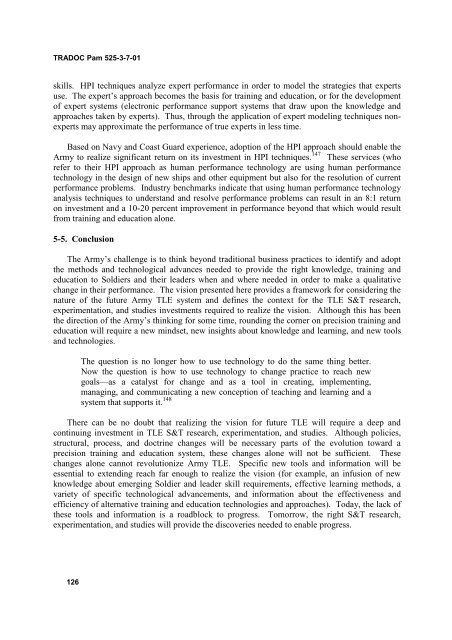TRADOC Pam 525-3-7-01 - TRADOC - U.S. Army
TRADOC Pam 525-3-7-01 - TRADOC - U.S. Army
TRADOC Pam 525-3-7-01 - TRADOC - U.S. Army
- No tags were found...
You also want an ePaper? Increase the reach of your titles
YUMPU automatically turns print PDFs into web optimized ePapers that Google loves.
<strong>TRADOC</strong> <strong>Pam</strong> <strong>525</strong>-3-7-<strong>01</strong>skills. HPI techniques analyze expert performance in order to model the strategies that expertsuse. The expert’s approach becomes the basis for training and education, or for the developmentof expert systems (electronic performance support systems that draw upon the knowledge andapproaches taken by experts). Thus, through the application of expert modeling techniques nonexpertsmay approximate the performance of true experts in less time.Based on Navy and Coast Guard experience, adoption of the HPI approach should enable the<strong>Army</strong> to realize significant return on its investment in HPI techniques. 147 These services (whorefer to their HPI approach as human performance technology are using human performancetechnology in the design of new ships and other equipment but also for the resolution of currentperformance problems. Industry benchmarks indicate that using human performance technologyanalysis techniques to understand and resolve performance problems can result in an 8:1 returnon investment and a 10-20 percent improvement in performance beyond that which would resultfrom training and education alone.5-5. ConclusionThe <strong>Army</strong>’s challenge is to think beyond traditional business practices to identify and adoptthe methods and technological advances needed to provide the right knowledge, training andeducation to Soldiers and their leaders when and where needed in order to make a qualitativechange in their performance. The vision presented here provides a framework for considering thenature of the future <strong>Army</strong> TLE system and defines the context for the TLE S&T research,experimentation, and studies investments required to realize the vision. Although this has beenthe direction of the <strong>Army</strong>’s thinking for some time, rounding the corner on precision training andeducation will require a new mindset, new insights about knowledge and learning, and new toolsand technologies.The question is no longer how to use technology to do the same thing better.Now the question is how to use technology to change practice to reach newgoals—as a catalyst for change and as a tool in creating, implementing,managing, and communicating a new conception of teaching and learning and asystem that supports it. 148There can be no doubt that realizing the vision for future TLE will require a deep andcontinuing investment in TLE S&T research, experimentation, and studies. Although policies,structural, process, and doctrine changes will be necessary parts of the evolution toward aprecision training and education system, these changes alone will not be sufficient. Thesechanges alone cannot revolutionize <strong>Army</strong> TLE. Specific new tools and information will beessential to extending reach far enough to realize the vision (for example, an infusion of newknowledge about emerging Soldier and leader skill requirements, effective learning methods, avariety of specific technological advancements, and information about the effectiveness andefficiency of alternative training and education technologies and approaches). Today, the lack ofthese tools and information is a roadblock to progress. Tomorrow, the right S&T research,experimentation, and studies will provide the discoveries needed to enable progress.126



